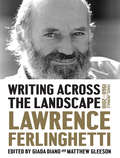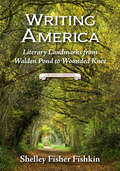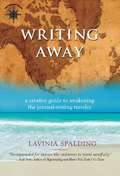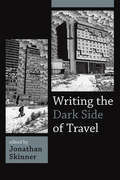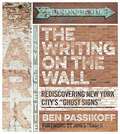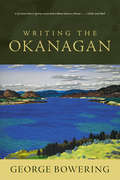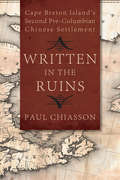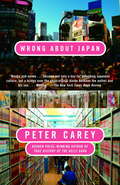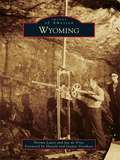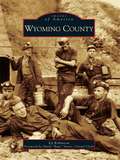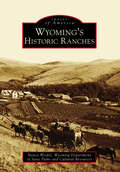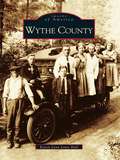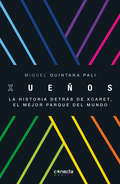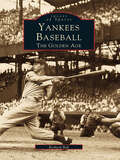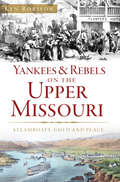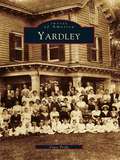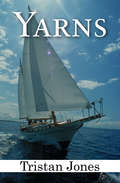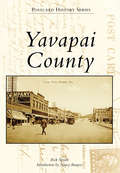- Table View
- List View
Writing Across the Landscape: Travel Journals 1950–2013
by Matthew Gleeson Lawrence Ferlinghetti Giada DianoThis long-awaited volume provides a panoramic portrait of art and life across the twentieth century, from Mexico to Morocco, Paris to Rome, and beyond. Over the course of an adventured-filled life, now in its tenth decade, Lawrence Ferlinghetti has been many things: a poet, painter, pacifist, publisher, courageous defender of free speech, and owner of San Francisco’s legendary City Lights bookstore. Now the man whose A Coney Island of the Mind became a generational classic reveals yet another facet of his manifold talents, presenting here his travel journals, spanning over sixty years. Selected from a vast trove of mostly unpublished, handwritten notebooks, and edited by Giada Diano and Matthew Gleeson, Writing Across the Landscape becomes a transformative work of social, cultural, and literary history. Beginning with Ferlinghetti's account of serving as a commanding officer on a Navy sub-chaser during D-Day, Writing Across the Landscape dramatically traverses the latter half of the twentieth century. For those only familiar with his poetry, these pages present a Lawrence Ferlinghetti never before encountered, an elegant prose stylist and tireless political activist who was warning against the pernicious sins of our ever-expansive corporate culture long before such thoughts ever seeped into mainstream consciousness. Yet first and foremost we see an inquisitive wanderer whose firsthand accounts of people and places are filled with pungent descriptions that animate the landscapes and cultures he encounters. Evoking each journey with a mixture of travelogue and poetry as well as his own hand-drawn sketches, Ferlinghetti adopts the role of an American bard, providing panoramic views of the Cuban Revolution in Havana, 1960, and a trip through Haiti, where voodoo and Catholicism clash in cathedrals "filled with ulcerous children's feet running from Baron Hunger." Reminding us that poverty is not only to be found abroad, Ferlinghetti narrates a Steinbeck-like trip through California's Salton Sea, a sad yet exquisitely melodic odyssey from motel to motel, experiencing the life "between cocktails, between filling stations, between buses, trains, towns, restaurants, movies, highways leading over horizons to another Rest Stop…Sad hope of all their journeys to Nowhere and back in dark Eternity." Particularly memorable is his journey across the Trans-Siberian Railway in 1957, which turns into a Kafkaesque nightmare in which he, lacking a proper visa, is removed from a Japan-bound freighter and forced back across the Russian steppe to Moscow, encountering a countryside more Tolstoy than Khrushchev, while nearly dying in the process. Readers are also treated to glimpses of Ezra Pound, "looking like an old Chinese sage," whom Ferlinghetti espies in Italy, as well as fellow Beat legends Allen Ginsberg and a dyspeptic William S. Burroughs, immured with his cats in a grotto-like apartment in London. Embedded with facsimile manuscript pages and an array of poems, many never before published, Writing Across the Landscape revives an era when political activism coursed through the land and refashions Lawrence Ferlinghetti, not only as a seminal poet but as an historic and singular American voice.
Writing America
by Shelley Fisher FishkinAmerican novelist E.L. Doctorow once observed that literature "endows places with meaning." Yet, as this wide-ranging new book vividly illustrates, understanding the places that shaped American writers' lives and their art can provide deep insight into what makes their literature truly meaningful. Published on the eve of the 50th anniversary of the Historic Preservation Act, Writing America is a unique, passionate, and eclectic series of meditations on literature and history, covering over 150 important National Register historic sites, all pivotal to the stories that make up America, from chapels to battlefields; from plantations to immigration stations; and from theaters to internment camps. The book considers not only the traditional sites for literary tourism, such as Mark Twain's sumptuous Connecticut home and the peaceful woods surrounding Walden Pond, but also locations that highlight the diversity of American literature, from the New York tenements that spawned Abraham Cahan's fiction to the Texas pump house that irrigated the fields in which the farm workers central to Gloria Anzaldúa's poetry picked produce. Rather than just providing a cursory overview of these authors' achievements, acclaimed literary scholar and cultural historian Shelley Fisher Fishkin offers a deep and personal reflection on how key sites bore witness to the struggles of American writers and inspired their dreams. She probes the global impact of American writers' innovative art and also examines the distinctive contributions to American culture by American writers who wrote in languages other than English, including Yiddish, Chinese, and Spanish. Only a scholar with as wide-ranging interests as Shelley Fisher Fishkin would dare to bring together in one book writers as diverse as Gloria Anzaldúa, Nicholas Black Elk, David Bradley, Abraham Cahan, S. Alice Callahan, Raymond Chandler, Frank Chin, Elizabeth Cook-Lynn, Countee Cullen, Frederick Douglass, Paul Laurence Dunbar, Jessie Fauset, William Faulkner, F. Scott Fitzgerald, Allen Ginsberg, Jovita González, Rolando Hinojosa, Langston Hughes, Zora Neale Hurston, Lawson Fusao Inada, James Weldon Johnson, Erica Jong, Maxine Hong Kingston, Irena Klepfisz, Nella Larsen, Emma Lazarus, Sinclair Lewis, Genny Lim, Claude McKay, Herman Melville, N. Scott Momaday, William Northup, John Okada, Miné Okubo, Simon Ortiz, Américo Paredes, John P. Parker, Ann Petry, Tomás Rivera, Wendy Rose, Morris Rosenfeld, John Steinbeck, Harriet Beecher Stowe, Henry David Thoreau, Mark Twain, Yoshiko Uchida, Tino Villanueva, Nathanael West, Walt Whitman, Richard Wright, Hisaye Yamamoto, Anzia Yezierska, and Zitkala-Ša. Leading readers on an enticing journey across the borders of physical places and imaginative terrains, the book includes over 60 images, and extended excerpts from a variety of literary works. Each chapter ends with resources for further exploration. Writing America reveals the alchemy though which American writers have transformed the world around them into art, changing their world and ours in the process. Table of ContentsList of Illustrations Acknowledgments Introduction: The Literary Landscape1 Celebrating the Many in One Walt Whitman Birthplace, Huntington, Long Island, New York2 Living in Harmony with Nature Walden Pond, Concord, Massachusetts3 Freedom's Port The New Bedford Whaling National Historical Park, New Bedford, Massachusetts4 The House that Uncle Tom's Cabin Built Harriet Beecher Stowe House, Hartford, Connecticut5 The Irony of American History The Mark Twain Boyhood Home, Hannibal, Missouri, and the Mark Twain House, Hartford, Connecticut6 Native American Voices Remember Wounded Knee, Pine Ridge Indian Reservation, South Dakota7 "I Know Why the Caged Bird Sings" The Paul Laurence Dunbar House, Dayton, Ohio8 Leaving the Old World for the New The Tenement Museum, New York City9 The Revolt from the Village The Original Main Street, Sauk Centre, Minnesota10 Asian American Writers and Creativ...
Writing Away
by Lavinia SpaldingTwo major trends have recently swept the travel world: the first, an overwhelming desire (thanks to Elizabeth Gilbert's bestseller, Eat, Pray, Love) to write one's own memoir; the second, an explosion of social media, blogs, twitter and texts, which allow travelers to document and share their experiences instantaneously. Thus, the act of chronicling one's journey has never been more popular, nor the urge stronger.Writing Away: A Creative Guide to Awakening the Journal-Writing Traveler, will inspire budding memoirists and jetsetting scribes alike. But Writing Away doesn't stop there-author Lavinia Spalding spins the romantic tradition of keeping a travelogue into a modern, witty adventure in awareness, introducing the traditional handwritten journal as a profoundly valuable tool for self-discovery, artistic expression, and spiritual growth.Writing Away teaches you to embrace mishaps in order to enrich your travel experience, recognize in advance what you want to remember, tap into all your senses, and connect with the physical world in an increasingly technological age. It helps you overcome writer's block and procrastination; tackle the discipline, routine, structure, and momentum that are crucial to the creative process; and it demonstrates how traveling-while keeping a journal along the way-is the world's most valuable writing exercise.
Writing The Dark Side Of Travel
by Jonathan SkinnerThe travel experience filled with personal trauma; the pilgrimage through a war-torn place; the journey with those suffering: these represent the darker sides of travel. What is their allure and how are they represented? This volume takes an ethnographic and interdisciplinary approach to explore the writings and texts of dark journeys and travels. In traveling over the dead, amongst the dying, and alongside the suffering, the authors give us a tour of humanity's violence and misery. And yet, from this dark side, there comes great beauty and poignancy in the characterization of plight; creativity in the comic, graphic, and graffiti sketches and comments on life; and the sense of profound and spiritual journeys being undertaken, recorded, and memorialized.
The Writing on the Wall: Rediscovering New York City's "Ghost Signs"
by James Trager Ben PassikoffThe New York Times' pick in "A Holiday Gift Guide for Hardcover Fans"A Publishers Weekly pick in "Holiday Gift Guide 2017: Illustrated Gift Books"A Photographic and Historical Record of the City’s Vanishing Advertisements As the great city of New York moves, changes, and evolves every day, the few remnants of its past go unnoticed. New York City’s "ghost signs” -advertisements painted across the facades of buildings that date back to the 19th century-are often invisible to the busy New Yorker, but defiantly conspicuous if only we turn our eyes and look upwards. These faded representations of the city’s rich economic and social history are slowly disappearing before our eyes, but not before they were captured by this photographer’s lens.At the tender age of sixteen, Ben Passikoff roamed around Manhattan with his camera to document these fascinating signs-hand-painted messages written all over the city. This photographic collection features signs painted in the 1800s as well as in the 21st century; signs that advertise funeral homes, meat, and underwear; signs stretched across iconic buildings; and even signs that are no longer legible. Using his photographs as a looking-glass into the past, Passikoff provides insightful commentary on the economic, social, and historical significance of commerce in New York City, and its vanishing ghost signs, now preserved in this photographic record.
Writing the Okanagan
by George BoweringGeorge Bowering was born in Penticton, where his great-grandfather Willis Brinson lived, and Bowering has never been all that far from the Okanagan Valley in his heart and imagination. Early in the twenty-first century, he was made a permanent citizen of Oliver. Bowering has family up and down the Valley, and he goes there as often as he can. He has been asked during his many visits to Okanagan bookstores over the years to publish a collection of his writing about the Valley.Writing the Okanagan draws on forty books Bowering has published since 1960 - poetry, fiction, history, and some forms he may have invented. Selections from Delsing (1961) and Sticks & Stones (1962) are here, as is "Driving to Kelowna" from The Silver Wire (1966). Other Okanagan towns, among them Rock Creek, Peachland, Vernon, Kamloops, Princeton, and Osoyoos, inspire selections from work published through the 1970s and on to 2013. Fairview, the old mining site near Oliver, is the focus of an excerpt from Caprice (1987, 2010), one volume in Bowering's trilogy of historical novels. "Desert Elm" takes as its two main subjects the Okanagan Valley and his father, who, as Bowering did, grew up there. With the addition of some previously unpublished works, the reader will find the wonder of the Okanagan here, in both prose and poetry.
Written in the Ruins: Cape Breton Island’s Second Pre-Columbian Chinese Settlement
by Paul Chiasson2017 Robbie Robertson Dartmouth Book Award — Shortlisted Paul Chiasson reveals the possibility that early Chinese settlers landed in Cape Breton long before Europeans. From the very beginning of the European Age of Discovery, Cape Breton was considered unusual. The history of the area even includes early references to the island having once been the land of the Chinese. In 1497, at least a century before any attempt at European settlement in the region, the explorer John Cabot had referred to Cape Breton as the “Island of Seven Cities.” The indigenous people of the region, the Mi’kmaq, were the only aboriginal people of North America who had a written language when Europeans first arrived. This writing, clothing, and customs also suggested an early Chinese presence. In Written in the Ruins, Chiasson investigates the ruins at St. Peters in the southern part of the island, where evidence brought to light supports a theory that could answer all the questions raised by the island’s curious, unresolved history.
Wrong About Japan: A Father's Journey with His Son
by Peter CareyPrevious winner of two Booker Prizes, Peter Carey expands his extraordinary achievement with each new novel -- but now gives us something entirely different. When famously shy Charley Carey becomes obsessed with Japanese manga and anime, Peter is not only delighted for his son, but entranced himself. Thus, with a father sharing his twelve-year-old's exotic comic books, begins a journey that will lead them both to Tokyo, where a strange Japanese boy will become both their guide and judge. The visitors quickly plunge deep into the lanes of Shitimachi -- into the "weird stuff" of modern Japan -- meeting manga artists and anime directors, "visualists" who painstakingly impersonate cartoons, and solitary "otakus" who lead a computerized existence. What emerges from these encounters is a pithy, far-ranging study of history and culture both high and low -- from samurai to salaryman, from kabuki theatre to the post-war robot craze. Peter Carey's observations are provocative, even though his hosts often point out, politely, that he is wrong about Japan. In adventures that are comic, surprising, and ultimately moving, father and son cope with and learn from each other in a place far from home. "No Real Japan," said Charley. "You've got to promise. No temples. No museums." "What could we do?" "We could buy cool manga." "There'll be no English translations." "I don't care. I'd eat raw fish." --excerpt from Wrong About Japan.
The Wrong Goodbye
by Toshihiko YahagiA classic slice of Japanese hard-boiled noir paying homage to the master of the genre: Raymond ChandlerThe Wrong Goodbye pits homicide detective Eiji Futamura against a shady Chinese business empire and U.S. military intelligence in the docklands of recession Japan. After the frozen corpse of immigrant barman Tran Binh Long washes up in midsummer near Yokosuka U.S. Navy Base, Futamura meets a strange customer from Tran's bar. Vietnam vet pilot Billy Lou Bonney talks Futamura into hauling three suitcases of "goods" to Yokota US Air Base late at night and flies off leaving a dead woman behind. Thereby implicated in a murder suspect's escape and relieved from active duty, Futamura takes on hack work for the beautiful concert violinist Aileen Hsu, a "boat people" orphan whose Japanese adoption mother has mysteriously gone missing. And now a phone call from a bestselling yakuza author, a one-time black marketeer in Saigon, hints at inside information on "former Vietcong mole" Tran and his "old sidekick" Billy Lou, both of whom crossed a triad tycoon who is buying up huge tracts of Mekong Delta marshland for a massive development scheme. As the loose strands flashback to Vietnam, the string of official lies and mysterious allegiances build into a dark picture of the U.S.-Japan postwar alliance. Translated from the Japanese by Alfred Birnbaum
The Wrong Goodbye
by Toshihiko YahagiA classic slice of Japanese hard-boiled noir paying homage to the master of the genre: Raymond ChandlerThe Wrong Goodbye pits homicide detective Eiji Futamura against a shady Chinese business empire and U.S. military intelligence in the docklands of recession Japan. After the frozen corpse of immigrant barman Tran Binh Long washes up in midsummer near Yokosuka U.S. Navy Base, Futamura meets a strange customer from Tran's bar. Vietnam vet pilot Billy Lou Bonney talks Futamura into hauling three suitcases of "goods" to Yokota US Air Base late at night and flies off leaving a dead woman behind. Thereby implicated in a murder suspect's escape and relieved from active duty, Futamura takes on hack work for the beautiful concert violinist Aileen Hsu, a "boat people" orphan whose Japanese adoption mother has mysteriously gone missing. And now a phone call from a bestselling yakuza author, a one-time black marketeer in Saigon, hints at inside information on "former Vietcong mole" Tran and his "old sidekick" Billy Lou, both of whom crossed a triad tycoon who is buying up huge tracts of Mekong Delta marshland for a massive development scheme. As the loose strands flashback to Vietnam, the string of official lies and mysterious allegiances build into a dark picture of the U.S.-Japan postwar alliance. Translated from the Japanese by Alfred Birnbaum(P)2021 Quercus Editions Limited
Wyoming
by Jay De Vries Norma LewisWyoming, Michigan, became a city in 1959, the same year Alaska and Hawaii became states, but its history began more than a century earlier. The first permanent settlers came in 1832, and in 1848, the region split, with the northern portion becoming Wyoming and the southern, Byron Center. Wyoming flourished. The farmers came first with the businesses that supported them. Industry followed. The various gypsum mines were among the earliest arrivals. General Motors built a stamping plant on Thirty-sixth Street that helped pull the township out of the Great Depression in 1936. It was a success, so the company built a diesel plant on Burlingame Avenue. Reynolds Metals, Steelcase, Light Metals, Bell Fibre, and others found Wyoming a good place to relocate. People wanted to live where they worked, and that meant an ever-increasing number of houses were built, followed by additional schools, churches, shops, and restaurants. Rogers Plaza was West Michigan's first enclosed mall. Though often contentious, the local government did its best to live up to an ambitious slogan, "Wyoming: the City of Vision and Progress."
Wyoming County
by Ed Robinson David Bugs" StoverBecause of its rich coal heritage and breathtaking scenery, many regard Wyoming County as the hidden gem of southern West Virginia. The county's vibrant history began with Native Americans, whom many believe left behind the petroglyphs that attract national attention, and continued to its early residents, who farmed and flourished in the logging industry. In 1906, when the Deepwater Railroad (later the Virginian) came to the town of Mullens, Wyoming County's role as a provider of the nation's natural resources was strengthened. By the 1920s, the county was one of West Virginia's foremost coal-producing counties; it maintains that position today. In addition to its integral part in resource exportation, Wyoming County is legendary for its sports scene. Such great players and coaches as Curt Warner, star running back of Penn State and the Seattle Seahawks; Mike D'Antonio, head coach of the Phoenix Suns; and Joe Pendry, assistant coach of the Houston Texans, got their start in Wyoming County. In recent years, this area has been best known for its recreational opportunities. Twin Falls State Park and R. D. Bailey Lake attract thousands of tourists annually, and the Coal Heritage Trail gives residents and visitors alike a chance to see how coal influenced the growth of the region.
Wyoming's Historic Ranches
by Nancy Weidel Wyoming Department of State Parks and Cultural ResourcesWyoming is so closely identified with ranching that it is often known as "the Cowboy State." The prosperity associated with the cattle industry drew wealthy investors to Wyoming Territory in the 1870s and early 1880s. They stocked the range with thousands of cows and made considerable fortunes until the harsh winter of 1886-1887, when the cattle market collapsed. Many of those early ranchers left Wyoming, which opened the door for the establishment of what would become a huge sheep business. During the 1890s and the early decades of the 20th century, the various Homestead Acts drew others to Wyoming in search of a brighter future. As most of Wyoming's land was suited for grazing, not farming, smaller ranches began to play a more important role in the state's growth. Wyoming's Historic Ranches provides a rare glimpse of the cattle baron ranches as well as the more modest operations that are tucked away along remote valleys and streams, not visible to the average visitor or resident of the state.
Wythe County
by Karen Lynn HallNestled in the heart of the Blue Ridge Mountains of Southwest Virginia lies the historically rich Wythe County. The area was originally settled due to the proximity of the New River, one of few rivers in the world that flows north. The county is named after George Wythe, signer of the Declaration of Independence. In 1863, the Civil War Battle of Wytheville brought federal troops into the heart of the county, hoping to interrupt the flow of necessary salt from the mines at nearby Saltville. During the 1800s, Wythe County was known for its mineral waters and as a mountain resort for wealthy residents of hot, humid areas who came for the summer to vacation. Having flourished throughout the 20th century, the county still retains its rural charm. Wythe County captures many charming scenes of country life, Virginia's train and travel industry, numerous long-forgotten vistas, some of Wythe County's finest citizens, and the area's most notable landmarks.
The Xenophobe's Guide To The Americans
by Stephanie FaulA preparatory travel guide for the apprehensive.
The Xenophobe's Guide to the English
by Antony MiallA preparatory travel guide for the apprehensive.
Xstabeth
by David KeenanINCLUDES 'PREQUEL' THE TOWER THE FIELDS THE TRANSMITTERS'This book spoke, it said "read me" from the very first sentence as if it were alive, it gave me visceral joy' Kim Gordon'Reading [Xstabeth] feels like being cut open to the accompanying sound of ecstatic music' Edna O'Brien'Prepare for more of that inimitable Keenan narrative voodoo brilliance' Wendy ErskineIn St Petersburg, Russia, Aneliya is torn between the love of her father and her father's best friend. Her father dreams of becoming a great musician but suffers with a naivete that means he will never be taken seriously. Her father's best friend has a penchant for vodka, strip clubs and moral philosophy.When an angelic presence named Xstabeth enters their lives - a presence who simultaneously fulfils and disappears those she touches - Aneliya and her father's world is transformed. Moving from Russia to St Andrews, Scotland, Xstabeth tackles the metaphysics of golf, the mindset of classic Russian novels and the power of art and music to re-wire reality. Charged with a consuming intensity and a torrential rhythm that pulses with music, it is an offering of transcendence and a love letter to the books of Chandler, Nabokov and Dostoevsky, by a writer who is rewriting the rulebook of contemporary fiction.
Xueños: La historia detrás de Xcaret, el mejor parque del mundo
by Miguel Quintana PaliXoñar es visualizar una gran idea en acción. «Tienes que aprender a xoñar bonito o, de lo contrario, despertar a tiempo». Miguel Quintana Pali Hay pocas historias en México que han cambiado la vida empresarial y social del país como la del arquitecto Miguel Quintana Pali, fundador y director general de Grupo Xcaret. El pionero del turismo sostenible sintetiza sus casi cinco décadas de experiencia como emprendedor-empresario -primero como tendero, luego como parquero y, ahora, hotelero- en una serie de consejos para quienes buscan iniciar un negocio y los musts para tener éxito. Desde sus primeros negocios escolares y la invención de una lámpara de mesa que lo hizo dar el salto a emprender y fundar las Tiendas Pali, Quintana cuenta cómo convirtió a Xcaret en una embajada de México que hoy recibe dos millones de visitantes al año y es conocido a nivel mundial. En un recorrido por su vida a la par que por la historia del Grupo Xcaret descubrimos cómo fueron surgiendo las ideas para los parques y el proceso de creación de algunas de las atracciones más emblemáticas, los retos para presupuestar una forma de arquitectura que respeta la naturaleza, las diferencias entre socios, la sostenibilidad 360º, las estrategias de operación y marketing, la innovación tecnológica inhouse, las distintas acciones sociales que se han vuelto parte del ADN del grupo y de su gente, la filosofía basada en la felicidad hacia dentro y fuera de la organización y finalmente los proyectos que están en el tintero o ya construyéndose para ser una realidad. Una mirada íntima al genio creativo de una de las mentes más divergentes y comprometidas con el desarrollo de México.
Xueños: La historia detrás de Xcaret, el mejor parque del mundo
by Miguel Quintana PaliXoñar es visualizar una gran idea en acción. «Tienes que aprender a xoñar bonito o, de lo contrario, despertar a tiempo». Miguel Quintana Pali Hay pocas historias en México que han cambiado la vida empresarial y social del país como la del arquitecto Miguel Quintana Pali, fundador y director general de Grupo Xcaret. El pionero del turismo sostenible sintetiza sus casi cinco décadas de experiencia como emprendedor-empresario -primero como tendero, luego como parquero y, ahora, hotelero- en una serie de consejos para quienes buscan iniciar un negocio y los musts para tener éxito. Desde sus primeros negocios escolares y la invención de una lámpara de mesa que lo hizo dar el salto a emprender y fundar las Tiendas Pali, Quintana cuenta cómo convirtió a Xcaret en una embajada de México que hoy recibe dos millones de visitantes al año y es conocido a nivel mundial. En un recorrido por su vida a la par que por la historia del Grupo Xcaret descubrimos cómo fueron surgiendo las ideas para los parques y el proceso de creación de algunas de las atracciones más emblemáticas, los retos para presupuestar una forma de arquitectura que respeta la naturaleza, las diferencias entre socios, la sostenibilidad 360º, las estrategias de operación y marketing, la innovación tecnológica inhouse, las distintas acciones sociales que se han vuelto parte del ADN del grupo y de su gente, la filosofía basada en la felicidad hacia dentro y fuera de la organización y finalmente los proyectos que están en el tintero o ya construyéndose para ser una realidad. Una mirada íntima al genio creativo de una de las mentes más divergentes y comprometidas con el desarrollo de México.
The Yangtze Valley and Beyond: An Account of Journeys in China, Chiefly in the Province of Sze Chuan and Among the Man-Tze of the Somo Territory
by Isabella Lucy BirdIsabella Bird was one of the greatest travelers and travel writers of all time, and this is her last major book, a sympathetic look at inland China and beyond into Tibet at the end of the 19th century. In describing the journey, Isabella provides a rich mix of observations and describes two occasions when she is almost killed by anti-foreign mobs. It many ways, Isabella created the model for travel writing today, and this one of her greatest works.
Yankees Baseball: The Golden Age (Images of Sports)
by Richard BakBetween 1920 and 1964, the Bronx Bombers dominated thegame of baseball. It was a time when baseball players enjoyed an elevated status as national icons, a time when men wearing baggy, flannel uniforms and sporting pancake gloves played for little more than "the love of the game." In this striking and nostalgic volume featuring many rarely seen photographs, we meet the heroes that were the New York Yankees. The Yankees won 29 American League pennants and 20 World Series during this golden era, their diamond exploits thrilling generations of fans and their statistical achievements becoming familiar numbers in the lore of the game: Babe Ruth's 714 home runs; Lou Gehrig's 2,130 consecutive games played; Joe DiMaggio's 56-game hitting streak; Casey Stengel's 5 straight world championships; Mickey Mantle's 565-foot home run; and Roger Maris's 61 round-trippers. The tradition of excellence began in the 1920s with the Murderers' Row teams, named for their "killer" batting lineups, and continued through the early 1960s, by which time the Bronx Bombers had established themselves as the most successful franchise in sports history.
Yankees & Rebels on the Upper Missouri: Steamboats, Gold and Peace (Military)
by Ken RobisonDuring the 1860s, the Missouri River served as a natural highway, through snags and rapids, from St. Louis to Fort Benton for steamboats bringing Yankees and Rebels and their families to the remote Montana territory. The migration transformed the Upper Missouri region from the isolation of the fur trade era to the raucous gold rush days that would keep the region in turmoil for decades. The influx of newcomers involved its share of dramatic episodes, including the explosion of the Chippewa triggered by a drunken crew member, the mystery of the fugitive James-Younger gang and Colonel Everton Conger's journey from capturing John Wilkes Booth to the Montana Supreme Court. Acclaimed historian Ken Robison reveals the thrilling history behind this war-weary wave of migration seeking opportunity on Montana's wild and scenic frontier.
Yardley (Images of America)
by Vince ProfyIn the eighteenth century, a ferry and mill marked the crossroads beginnings of Yardleyville in Makefield Township. New modes of transportation transformed the village, commerce and industry flourished, and the populationincreased substantially. Soon the people of Yardley yearnedfor their own government--their own town--and Yardley,Pennsylvania, was incorporated in 1895. Yardley is a unique, detailed look at the birth and growth of the borough. When Yardley Borough celebrated its centennial, donations and loans of photographs revealing Yardley's history were collected. This volume is compiled mostly from this locally assembled selection of images, and recounts Yardley'shistory with eloquence. These pages revisit the cigar stores, trolley tracks, ice cream shops, schools, the intersection of Main and Afton, and many other well-known sites throughout the borough. The face of the old toll collector, the festivitiesof the "Canal Days" and "Harvest Day" celebrations, and countless days at Lake Afton, the canal, or the river are all captured in this treasured account of Yardley's past.
Yarns (World Of Cruising Ser.)
by Tristan Jones&“A pleasure . . . a brilliant collection of yarns about [a British mariner&’s] life, his sailing adventures, and his thoughts about man and the sea.&” —Lloyd's List In Yarns, legendary sailor and adventurer Tristan Jones tells stories of his remarkable life at sea. Along with tales of the beautiful cruises he has made around the world and the memorable people he has met along the way, Jones has advice for his readers on everything from captaining a boat to engaging with locals in remote locations. He proposes his own theory for the mystery of the ghost ship Mary Celeste. Other yarns include a story of a troubled steamship, his accounts of an unlikely salvage operation in Ibiza, a strange rendezvous on the coast of Africa, and his chance encounter with a renowned American sailor. Jones even shares what prompted him to begin writing in the first place—a turn of fortune that sailing and reading fans have lauded him for ever since. &“The characters and capers, including a Sherlock Holmes-style mystery, pour deliciously from the pen of this legendary adventurer.&” —Cruising World
Yavapai County (Postcard History Series)
by Nancy Burgess Rick SprainIn 1864, Arizona was divided into four counties named after the local Indian communities: Yavapai, Yuma, Mohave, and Pima. Believed to have been the largest county ever created in the lower 48 states at the time, Yavapai encompassed over 65,000 square miles until 1891, when the state was divided into additional counties. Yavapai finally settled to 8,125 square miles. While still a US territory in 1900, Yavapai County had a population just under 13,800 people and was quite remote. Within a few years, postcards started appearing in drugstores, such as Brisley, Timerhoff, Owl, Heit, Corbin and Bork, or Eagle Drug in Prescott and Lynn Boyd or Mitchell in Jerome. Many of the original postcards showcase early mines, towns, and buildings that no longer exist today.
